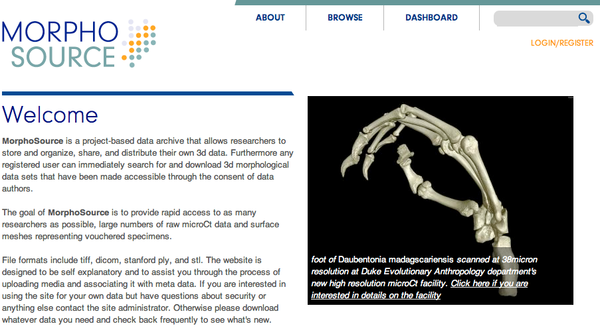
Submitted 19 February 2015 by Doug M. Boyer

Authors
Doug M. Boyer (1), Seth Kaufman (2), Gregg F. Gunnell (3), Edward Gomes (4), James O. Thostenson (5)
Affiliations
(1) Duke University, Trinity College of Arts & Sciences, Department of Evolutionary Anthropology, Durham, NC, USA; (2) Whirligig Inc., Greenport, NY, USA; (3) Duke University, Duke Lemur Center, Division of Fossil Primates, Durham, NC, USA; (4) Duke University, Trinity College of Arts & Sciences, Durham, NC, USA; (5) Duke University, Pratt School of Engineering, Department of Electrical Engineering, Durham, NC, U.S.A.
Overview
This article announces the existence of MorphoSource, the first project-based data archive for storing, collaborative sharing, and distribution of microCT scans, 3D surface renderings, and 2D digital imagery of specimens (http://www.morphosource.org/). The site has been active since April 2013 (Boyer et al. 2014a, b; Kaufman et al. 2014). It currently includes nearly 200 registered participants from across the globe. In terms of datasets, it hosts ~4,900 files representing ‘raw’ microCT volumetric data; mesh files (stl, ply) from laser scans, structured light, photogrammetry, or microCT; and 2D digital photographs. These files represent ~1,500 repository-vouchered specimens from 48 institutions. The holdings are growing rapidly. Data on the site is protected by creative commons restrictions as customized by each contributing researcher (data author) according to his/her needs, concerns or third party agreements (e.g., with museums). Most data published on the site can be immediately downloaded by registered users. Other datasets can be released for downloaded upon request by data authors who retain rights to grant third party access. This framework serves the interests of both physical repositories (museums) and data authors by tracking use statistics on datasets. Such statistics provide evidence of collection value and magnify impact of researcher-collected data. Datasets currently have unique identifiers that must be cited in publications using them. Coming soon, MorphoSource will also provide an avenue for DOI registry of certain datasets. MorphoSource provides search tools to allow users to find, and batch download the samples most relevant to their research design. Researchers who wish to use MorphoSource as a venue for providing access to their datasets must gain permission from a site administrator to begin this process. Once permission has been granted, contributors start a ‘data project’ into which they upload specimen data. The data project can be kept private or access can be granted to collaborators. When the contributor is ready, he/she releases the data project to the public archive. MorphoSource is free to users and contributors, and the amount of storage space is not explicitly limited. The network storage is distributed between multiple physical locations as part of Duke University’s IT and library data infrastructure. MorphoSource is currently looking to broaden its scope and capacity by partnering with other interested institutions.
MorphoSource was created to meet a demand arising from one of the most profound changes in specimen-based research today: the rapid transition to use of measurements and visualizations of digital models in place of physical objects. It aims to tap into an exciting opportunity that comes from an increasing reliance on three dimensional (3D) digital data: the potential for improving researcher access to relevant comparative samples. The majority of a researcher’s time and financial investment is currently spent traveling and arranging access to comparative samples. With extensive digitization of world-wide collections followed by consolidation of those collections on openly accessible, MorphoSource-like web archives serving as ‘virtual museums’, that investment can be dramatically minimized, while also eventually significantly increasing average sample sizes and improving the comparability and reproducibility of specimen-based research. In fact, providing effective access to digital datasets has become increasingly mandated by federal funding agencies acting in compliance with a 2013 executive order from the White House requiring data to be publicly accessible and machine-readable. Yet, the prospect of researchers contributing scan data to online 3D digital collections is a controversial topic because of the large investment of time and money required to acquire scans, perceived difficulty in tracking or ensuring quality of contributed scans, museum aversion to distribution of 3D media representing specimens in their collections, and high cost of maintaining live, networked digital storage for large numbers of scans. In the last decade, 3D scanner speeds have improved, and facility fees and the cost of digital storage have decreased appreciably. These factors and funding agency requirements motivated the development of the MorphoSource infrastructure for 3D data sharing. A few museums and scanning facilities have now begun posting 3D datasets online, however, there is no official venue for individuals not affiliated with these particular institutions to share datasets. MorphoSource serves as proof-of-concept for what such a repository-consolidating venue could look like, addressing the concerns and needs of museums and researchers alike, and is intended to fill the niche for as long as needed.
MorphoSource is here for you, whether you are student, faculty, museum curator, collections manager, or unaffiliated. Check it out athttp://www.morphosource.org/
References
Boyer DM, Kaufman S, Gunnell GF, Gomes E, Thostenson J. 2014. MorphoSource: A currently active project-based 3D digital web-accessible data archive for museums and individuals at Duke University USA. In: Mallison H, Vogel J, and Belvedere M, editors. Digital Specimen 2014 - Abstracts of Presentations. p http://www.naturkundemuseum-berlin.de/forschung/tagungen/digitalspecimen-berlin-2014/home/abstracts-of-presentations/.
Boyer DM, Kaufman S, Gunnell GF, Rosenberger AL, and Delson E. 2014b. Managing 3D digital data sets of morphology: MorphoSource is a new project-based data archiving and distribution tool. Am J Phys Anthro 153(s58):84A.
Kaufman S, and Boyer DM. 2014. Developing Platforms for Management and Distribution of Digital Specimen Data. In: Mallison H, Vogel J, and Belvedere M, editors. Digital Specimen 2014 - Abstracts of Presentations. p http://www.naturkundemuseum-berlin.de/forschung/tagungen/digitalspecimen-berlin-2014/home/abstracts-of-presentations/.
Figure - screenshot of MorphoSource homepage
Copyright © 2024 American Association of Biological Anthropologists.
Site programming and administration: Ed Hagen, Department of Anthropology, Washington State University